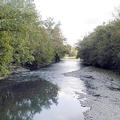 美國地質調查局(USGS)3日公佈的一項最新報告中指出,過去一整年來,不論是在美國的都會區或農業地區,大部分的溪流中皆檢驗出殺蟲劑成分。此份報告的數據,主要是在從加州到西北太平洋地區、夏威夷和阿拉斯加這段區域之中,主要的51個河谷盆地和地下蓄水層系統進行資料的收集,以及一份高原地帶地下蓄水層的區域研究。
美國地質調查局(USGS)3日公佈的一項最新報告中指出,過去一整年來,不論是在美國的都會區或農業地區,大部分的溪流中皆檢驗出殺蟲劑成分。此份報告的數據,主要是在從加州到西北太平洋地區、夏威夷和阿拉斯加這段區域之中,主要的51個河谷盆地和地下蓄水層系統進行資料的收集,以及一份高原地帶地下蓄水層的區域研究。
美國地質調查局研究人員發現,雖然水中殺蟲劑濃度鮮少有達到危害人體的程度,但仍可能影響許多溪流中的水生動物或食魚野生動物,特別是在城市與農業區的水體中。此外,她們也發現地下水較少出現有毒化學物質。
美國地質調查局這份報告涵括1992年到2001的研究,其中發現,殺蟲劑很少單獨出現,多數成分往往是複雜的混合物。大部分的溪流樣本以及約半數的井水樣本常發現兩種殺蟲劑物質,甚至常常是兩種以上。
殺蟲劑混合物在溪流中普遍出現,意味著殺蟲劑在水中、沉積物以及魚類中總合的毒性可能比任何單一種殺蟲劑來得大。
專寫報告的資深研究員基爾理恩(Robert Gilliom)認為,我們應優先搞清楚「殺蟲劑混合物」在溪流裡會發生什麼情形。他表示:「污染混合物對人體、水生生物和食魚野生生物可能的影響,我們的認識仍非常貧乏。因為我們當前所使用的毒性指標或水質測量標準,都是以個別化學物質的效果為基礎。」
他表示:「對於混合物影響的研究仍舊在起步階段,而且可能需要花費研究者許多年的時間,才能對其潛在效果有進一步的認識。」
此份報告,「國家溪流與地下水中的殺蟲劑,1992-2001」,可在以下網址查詢:http://water.usgs.gov/pubs/circ./circ1291。關於更深入的殺蟲劑評估資訊可查下列網站的「最新消息」欄位:http://water.usgs.gov/nawqa。
Pesticides are present throughout the year in most streams in urban and agricultural areas of the United States, according to a new report released by the U.S. Geological Survey on Friday. The report is based on data from 51 major river basins and aquifer systems from Florida to the Pacific Northwest, Hawaii and Alaska, plus a regional study in the High Plains aquifer system.
The pesticides are seldom found at concentrations likely to affect humans, but they may affect aquatic life or fish-eating wildlife in many streams, particularly those draining urban and agricultural areas, the USGS researchers learned. The toxic chemicals are less common in ground water, they found.
The USGS study, which covers the years 1992-2001, found that pesticides seldom occurred alone but almost always as complex mixtures. Most stream samples and about half of the well samples contained two or more pesticides, and frequently more.
The common occurrence of pesticide mixtures in streams, means that the total combined toxicity of pesticides in water, sediment, and fish may be greater than that of any single pesticide in a stream.
Senior author Robert Gilliom puts a high priority on understanding more about what happens when pesticides mix together in streams. "The potential effects of contaminant mixtures on people, aquatic life, and fish-eating wildlife are still poorly understood and most toxicity information, as well as the water-quality benchmarks used in this study, has been developed for individual chemicals."
"Studies of the effects of mixtures are still in the early stages," he said, "and it may take years for researchers to attain major advances in understanding the actual potential for effects."
The report, "Pesticides in the Nation's Streams and Ground Water, 1992-2001," Circular 1291 is available at http://water.usgs.gov/pubs/circ./circ1291. In-depth information about the pesticide assessment may be found at: http://water.usgs.gov/nawqa/ under "What's New."




